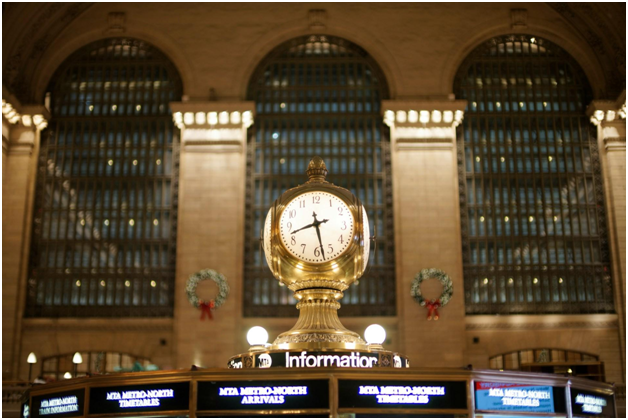Alex Kleyner: Framing Grand Central’s Soul

In the heart of New York City, where the pulse of urban life beats the strongest, Alex Kleyner stands as a beacon of creativity and insight. With a background that traverses the sunny shores of Miami to the bustling streets of New York, Kleyner has established himself as an iconic figure in architectural photography. His connection to New York City, enriched by his professional foray into capturing its architectural marvels, brings us to the focus of our narrative: Grand Central Terminal through the lens of Alex Kleyner.
Alex’s Perspective on Grand Central Terminal
Grand Central Terminal, a symbol of New York City’s architectural and historical grandeur, has captivated many, including Kleyner. His fascination with the terminal is not just about its role as a transportation hub but also about its embodiment of New York’s spirit. Kleyner sees it as a “living museum,” showcasing the city’s architectural evolution and its relentless pace. The celestial ceiling in the Main Concourse, with its azure backdrop and gilded constellations, represents, for Kleyner, the blend of art and functionality. The four-faced clock, a meeting point for millions, symbolizes the countless stories that have unfolded within the terminal’s walls.
The Fascination Behind the Lens
For Kleyner, Grand Central Terminal stands out as a testament to the city’s unyielding ambition and its architectural finesse. Capturing its essence is both a challenge and an opportunity; it demands an understanding of light and shadow, the movement of people, and the stillness of its stone. Kleyner approaches this iconic subject with a reverence for its history and an eye for the unique stories it tells, making his work not just a photograph but a narrative.
Technical Insights
In translating the grandeur of Grand Central Terminal into a photograph, Alex Kleyner employs a meticulous technique that balances natural and artificial light, capturing the terminal’s vibrancy. His choice of equipment is precise, favoring lenses that can encompass the vastness of the concourse while capturing the intricate details of its architectural features. Lighting plays a crucial role in his work, with early morning or late afternoon shoots to capture the soft glow that fills the space. Post-processing is a thoughtful exercise in enhancing the natural beauty of the image without detracting from the authenticity of the scene.
Exploring the Visual Symphony
Alex Kleyner’s work transcends mere photographic captures; it delves into the soul of Grand Central Terminal, presenting it as a visual symphony where every element plays a crucial part in the narrative. For Kleyner, the terminal is not just an architectural feat; it’s a canvas where light, shadow, and human elements interact in harmony. This perspective is particularly evident in his approach to capturing the terminal’s bustling atmosphere without losing the serenity of its architectural details. Each photograph tells a story of time and place, reflecting Kleyner’s ability to freeze moments of dynamic contrast within the ever-moving city.
The Historical Context Through a Modern Lens
Kleyner is deeply aware of the historical significance of Grand Central Terminal, understanding its transformation over the years from a mere transit point to an iconic landmark of New York City. His photographs aim to bridge this historical context with a modern aesthetic, offering viewers a layered experience of time. By focusing on elements like the Beaux-Arts architecture and the terminal’s role in the city’s development, Kleyner’s work serves as a conduit between the past and present, inviting a reflection on the terminal’s enduring legacy.
A Photographer’s Ethos
Behind every shot, there’s an ethos that drives Alex Kleyner’s work. This ethos is built on respect for architecture as an art form and a commitment to authenticity in how stories are told. Kleyner’s approach is methodical and introspective, reflecting a deep-seated belief in the power of visuals to convey complex narratives. This philosophical underpinning is what makes his photographs of Grand Central Terminal stand out—they’re not just images but expressions of respect towards architectural integrity and the narratives embedded within urban landscapes.
The Role of Technology in Architectural Photography
In the digital age, technology plays a pivotal role in architectural photography, something that Kleyner embraces with enthusiasm. From advanced DSLR cameras to sophisticated software for post-processing, technology is an essential tool in Kleyner’s arsenal. However, he maintains that technology should enhance rather than overshadow the essence of the subject. His use of technology is judicious, aimed at bringing out the true character of Grand Central Terminal in his photographs. This balance between technology and artistry is a testament to Kleyner’s mastery of his craft.
Engaging with the Audience
Finally, Alex Kleyner’s work is not just about capturing and presenting; it’s about engaging with an audience, sparking curiosity, and fostering an appreciation for architectural beauty. Through exhibitions, online platforms, and publications, Kleyner invites viewers into his visual world, offering them a glimpse into the intricate relationship between space, time, and architecture. His photographs of Grand Central Terminal, rich in detail and narrative, become a medium for dialogue with viewers, encouraging them to explore the depths of architectural photography and discover the stories that buildings, especially those as iconic as Grand Central, have to tell.
In weaving together these additional narratives, the editorial not only highlights Alex Kleyner’s profound connection with Grand Central Terminal but also deepens the exploration of his artistic process, his philosophical approach to photography, and the impact of his work on the audience. This expanded narrative enriches the original piece, offering readers a comprehensive look at Kleyner’s vision and the timeless allure of one of New York City’s most celebrated landmarks.




